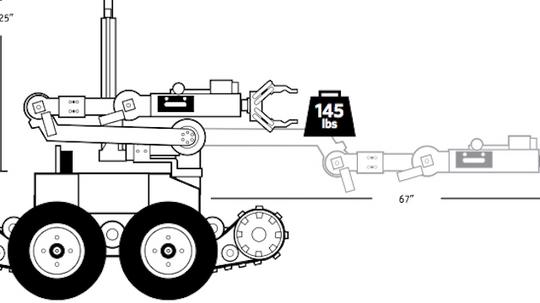
The Dallas Police Department used a robot made by a Northrop Grumman subsidiary to carry and detonate the explosive that killed Micah Johnson, a suspect in the Dallas police shootings. The Dallas PD on Monday announced that it had used an Andros MarkVA-1, built by the Falls Church, Va.-based defense giant's subsidiary Remotec. The robot was built for the reverse purpose, bomb disposal.
The robot used was a Remotec Andros Mark V-A1
— Dallas Police Depart (@DallasPD) July 11, 2016
This appears to be the first time a robot has been used by domestic police to apply lethal force. Holed up with weapons and ammunition as Johnson reportedly was, the robot was a way to reach him without risking anyone else's life, but the decision to attach C4 and a detonator instead of other incapacitating weapons or using the robot for communication stands out as unique.
Bomb disposal robots, usually called Explosive Ordinance Disposal (EOD) robots in the industry, are not a new idea. Remote control tanks were used by the Soviet Union in World War II to, among other activities, drive over mines. Better robotics and wireless communication technology had augmented the potential for robots to handle dangerous activity to an amazing extent today.
The technology for robots like this combine simple tools and cutting-edge applications. The gripper and arms, the usable as needed treads and the camera attachments of the Andros MarkV--A1 have analogues in everyday industry. But it uses cutting-edge sensory equipment and the design is deliberately modular, so it can add custom tools like laser sights, a cordless drill or even a shotgun. And the software is very much military-grade, making it potentially far more capable than a consumer version might be.
The Andros is only one of Northrop Grumman's remote control robots, and at $180,000, it's at the lower end of the pricing scale. The company is also behind the Cutlass, another EOD robot, but a much heavier one at 925 lbs, compared to the 490 lbs of the Andros. Northrop also builds other kinds of remote vehicles like the Carry-all Modular Equipment Landrover (CaMEL), which helps carry gear for troops as well as weapons. It's also heavily armored and can act as a shield or the weapon toting Wheelbarrow.
Though lighter than the Cutlass, the Andros can carry 60 lbs with a fully extended arm, significantly less than the one pound of C4 and detonator strapped to it last week. And it has treads that can be used for going up and down stairs.
Northrop's creations have been used by U.S. military and law enforcement agencies, but there are others. India's Defence Research and Development Organisation built a wheeled robot called Daksh to handle recovering bombs. Deliberately built with almost entirely Indian components, it can scan objects with a portable X-Ray, even look for car bombs, and use a water jet to defuse them. Meanwhile, the British military generally uses the Panama, created by London-based PA Consulting Group. The Panama is very low-cost, with the whole project costing a little less than $69 million thanks to using an already obsolete Land Rover for the body.
This appears to be the first time that an Andros robot has been used to actually cause an explosion deliberately, but the 30 lbs Multi-function Agile Remote-Controlled Robots (MARCbot) designed by Exponent was used early on in Afghanistan and Iraq by the military to deliver bombs remotely. The $19,000 MARCbot is outdated now and is a far simpler machine than the Andros models. There's also Endeavor, a Massachusetts-based company that used to be the defense division of iRobot before getting acquired by Washington, D.C.-based private equity firm Arlington Capital Partners earlier this year. It tends to specialize in small, rugged robots with less gear and weight, which makes them less likely to survive an explosion but offers more speed and maneuverability in some cases.
The technology is popular enough to make it uncertain at first what kind of robot was used in the Dallas case. After years of unmanned aerial systems, drones, being used by the U.S. to target and bomb enemy combatants, the idea of remote-controlled explosive delivery is pretty well understood, but the ethics of it are far from resolved.
The police deciding to use an explosion to take Johnson down may be deemed by some as excessive, especially as he was, while still dangerous, not actively shooting at that moment. And bombs are not precision tools. While no one else was hurt in this explosion, there's room for a tragic mistake. There is no obvious answer to the ethical question, but the technology demands we come up with some good ones, soon.




